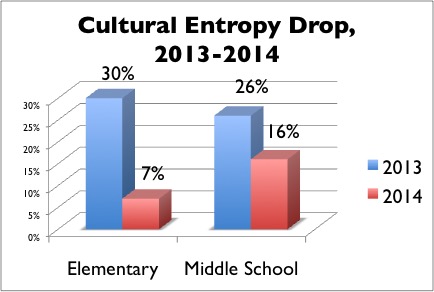Culture: Name It, Measure It, and Manage It
Ever sense something is flawed or missing in how things “get done around here” but can’t quite name it?
A newly hired school superintendent felt this and, despite pushback from a handful of leaders who had grown complacent with status quo, decided to do something about it. She knew that the values that shaped how education happens had never been made explicit, let alone consistent, generating inconsistent results. Staff morale was at an all-time low, and attrition had reached 40% – a costly trend for her network of nonprofit community schools. Her aim as the new sheriff in town: to make radical improvements to school culture, and to engage all teachers and staff in designing the school culture they believed would be:
- Financially sustainable – within budget
- Compliant – consistent with state/federal regulatory requirements, combined with the school community’s homegrown recipe for self accountability, “metrics that matter”
- Enriching – create a school community and place of work where staff, teachers, students and families all thrived.
Even in the best of circumstances, schools require intentional design – design of physical spaces, roles, and processes, as well as the design of a thriving culture. If they can name and measure it, they can manage it.
Enter the Barrett Values Centre (BVC) and Appreciative Inquiry (AI).
Step 1: get the data – baseline metrics
Data would provide a means to align school culture with strategic priorities, like higher student performance, increased family and community engagement, and accountability around metrics that matter.
Newsflash: values equal data.
 Moreover, by naming and even measuring values, a school can turn implicit cultural norms into explicit actions, structures, processes and roles for thriving.
Moreover, by naming and even measuring values, a school can turn implicit cultural norms into explicit actions, structures, processes and roles for thriving.
And so a BVC Cultural Values Assessment, or CVA, was introduced to the diverse school community. This 3-question survey elicited staff and administration perceptions of:
(A) Personal values – words to describe individual values
(B) Current culture values – words to describe the current culture
(C) Desired culture values – words to describe the school’s desired culture, the ideal
…and collated the 450+ responses to measure areas of:
- Cultural alignment (or lack thereof), e.g. degree of staff connection to the organization, level of confidence in the school’s direction
- Entropy, or wasted energy/productivity, as measured by the potentially limited values chosen, and
- Revealing the most desired values as antidotes (self-prescribed solutions).
Step 2: help school staff to interpret and own the data findings
 Using a homegrown mix of AI workshops and debriefing sessions, staff worked together to make sense of the CVA insights and own the CVA findings. More than articulating core values, staff defined them and identified sample behaviors to render the implicit cultural values explicit, day-to-day.
Using a homegrown mix of AI workshops and debriefing sessions, staff worked together to make sense of the CVA insights and own the CVA findings. More than articulating core values, staff defined them and identified sample behaviors to render the implicit cultural values explicit, day-to-day.
The outcome: new staff-designed structures, roles, and work processes to further increase cultural alignment, reduce entropy, and turn the most desired cultural values (antidotes) into action.
Step 3: implement through experiment
Among these new structures was the creation of a values-based recruitment and interview process for hiring a new principal to oversee an already low-performing elementary and middle school. Morale was on the decline, and entropy (or wasted productivity) measured 30% and 26% at the elementary and middle school, respectively (no surprise, given the dangerously high staff turnover).
A staff-prescribed solution: hosting new “meet and greet” recruiting events to gauge prospective candidate fit, as well as experimentation with new behavioral interviews that included story-seeking questions to reveal the true character of carefully vetted candidates.
One candidate rose to the top of the list following the new values-based interview process. He was unconventional in a manner that was met with resistance by several selection panelists, and yet he aced the behavioral interviews, his values entirely consistent with the core values now being sought by staff. The job was his, and his charge a mighty one: to turn around the schools in ways that were manageable and measurable.
Step 4: measure impact – re-assess annually
Fast forward 12 months into 2014, where the CVA survey and debriefing process was repeated for all 450+ staff and administrators. Below is just one example of the drastic reductions in cultural entropy, as measured by the CVA 2013-14, for the elementary and middle school under the new principal’s leadership. The elementary school measured a 23% reduction (from 30% to 7%) and the middle school a 10% reduction (from 26% to 16%).
The new principal was doing his job, and well.
Testimonial evidence gathered in focus groups and staff surveys revealed the how’s behind the schools’ recipe for change and dramatic improvements to morale, from community partnerships (in and out of school), to more culturally “fitting” means for family engagement, to intentional teamwork, to include collaborative curriculum design by grade levels across schools, making wiser use of teacher time and work-life balance, as well as innovations in teacher-administrator-family communications—leveraging free and existing (yet underutilized) technologies and mobile apps.
Visible or invisible, tangible or intangible, values are data. Culture is measurable and manageable. And, for better or worse, we design culture in the everyday processes, roles, and behaviors we all too often take for granted.
Want to improve how things “get done around here”? Bring a little intention to work and design the culture you most desire–inclusively. And be prepared to measure it, meaningfully, holding yourself and each other accountable for being the change you want to see. People commit to what they help to create.
Authored by Jen Hetzel Silbert and Cheri Torres












Leave a Reply
Want to join the discussion?Feel free to contribute!